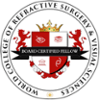What is Age-Related Macular Degeneration?

The eye is an incredibly complex organ with over 2 million components, all of which are essential to one of our most valuable functions – our vision. But with so many moving parts, our eyes are susceptible to a wide range of problems, from common refractive errors to serious diseases. One condition that can cause significant impairment to our vision is age-related macular degeneration.
A Common Cause of Vision Loss
Macular degeneration affects the central area of the retina at the back of the eye, called the macula. The condition is most common in people over the age of 60, hence the name “age-related macular degeneration” – also abbreviated to AMD. It is a leading cause of vision loss among people over the age of 50.
AMD develops when age-related damage begins to affect the macula. This part of the eye processes what we see in our central vision, allowing us to make out fine details, both up close and in the distance. While people with AMD may not immediately notice any changes in their vision, others will experience much faster deterioration which can lead to complete loss of central vision.
The condition is not associated with complete vision loss; however, loss of central vision can make everyday tasks such as reading, writing, and driving more difficult. Many patients with AMD also find that they have difficulty recognising the faces of people they know.
AMD can affect one or both eyes and symptoms worsen over time. These symptoms can include:
- Blurred vision
- A dark spot in the central vision
- Distortion of straight lines
- Objects appearing the wrong size, shape, or colour
- A blind spot or objects moving or disappearing
- Difficulty in bright sunlight and dim lighting
If you are over 50 and you notice any of the above symptoms, you should mention it to your doctor at your next eye exam. There are many things you can do to help slow down and manage the condition. But before we get into that, let’s look first at the different types of AMD:
The Different Types of Age-Related Macular Degeneration
There are two forms of age-related macular degeneration: Dry and wet.
Dry AMD
Dry AMD (also known as atrophic AMD) is the most common form of the condition, accounting for around 90% of cases. Dry AMD happens in three stages: early, intermediate, and late.
The cells of the macula (including photoreceptors and pigment epithelium) slowly break down – this can occur slowly over several years. This can cause the colour of the macula to change and a build-up of waste product in the retina, leading to the deterioration and weakening of the retina in the early stages.
The condition often doesn’t progress beyond these signs – most people over 50 experience this to some degree without any real issue. There is no treatment for late dry AMD, though vision aids can help to reduce the effect of symptoms.
Wet AMD
Wet age-related macular degeneration (also called advanced neovascular AMD) is a less common form of the condition, affecting around 10% of patients. It occurs when abnormal blood vessels grow in the back of the eye and cause damage to the retina and macula. This damage results in scarred tissue in the back of the eye and distorted vision. Wet AMD is usually associated with faster vision loss than the dry variation of the condition.
Any stage of dry AMD can turn into wet AMD; however, wet AMD is always a late stage of the condition. Some treatments may be effective at slowing the progression of wet AMD.
End-stage AMD
As you can imagine from the name, end-stage AMD is the most advanced form of the condition. In people over 65, it is the leading cause of vision loss and blindness.
As mentioned, some wear and tear of the macula are normal during ageing. In end-stage AMD, however, this normal degeneration has turned into a condition that causes irreversible vision loss.
In end-stage AMD, the macula can reach a point where central vision is lost in both eyes, making it difficult to perform everyday tasks. When AMD gets to this stage, no medications or treatments can help reverse the vision loss and bring back your central sight. You may still have perfectly good side vision or peripheral vision, but it is too low resolution to make up for the lost central vision.
Preventing and Treating AMD
The cause of AMD is not completely understood, but some factors are thought to contribute to the risk of developing the condition. These include:
- Having a family history of AMD
- Ethnicity – AMD is more common among Caucasian people
- Smoking
It is possible to check for AMD as part of a comprehensive dilated eye exam. To perform this examination, your eye doctor will administer eye drops to dilate your pupils. This allows them to look into your eyes for AMD and other problems.
Depending on the type of AMD, there may be various treatment options available.
There is no treatment for early-stage AMD. Your eye doctor will keep an eye on the progression of the condition and will likely recommend lifestyle changes, including eating healthily, getting regular exercise, and quitting smoking.
If you have intermediate dry AMD, special dietary supplements, including certain vitamins and minerals, may help to prevent it from turning into late AMD or slow down the progression of late AMD.
Several medications and laser treatments have been developed for the treatment of wet AMD. They each have their own benefits and limitations and should be discussed comprehensively with an eye care professional. These treatments are medicines called anti-VGEF drugs that a doctor will inject into the eye, and photodynamic therapy (PDT) – a combination of injections and laser treatment.
We currently have various patient studies running at London Vision Clinic to treat AMD, you can find out more here.
If you’ve been diagnosed with AMD or believe you may be at risk, talk to your eye doctor about how the condition may affect your vision and what you can do to help retain your vision and keep your eyes healthy. Find out if you could still be suitable for Laser Eye Surgery if you have AMD, here.
Have any further questions? Get in touch with one of our friendly clinic coordinators – we’re always happy to help. If you’d like to learn more about treatments at London Vision Clinic, Book a Consultation today.


